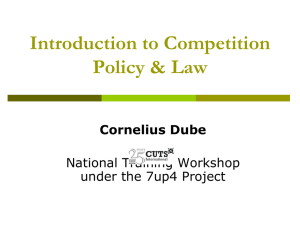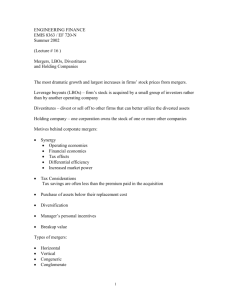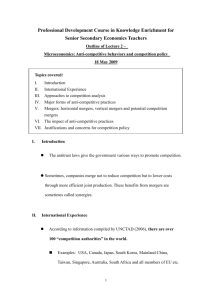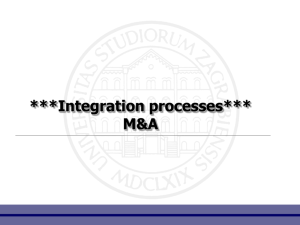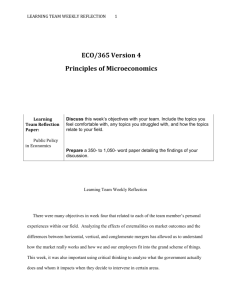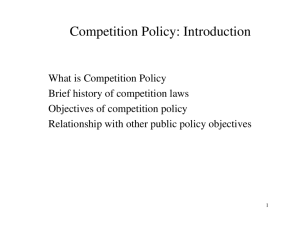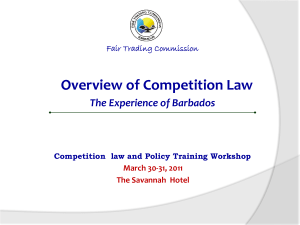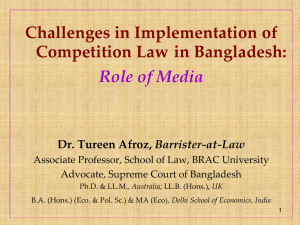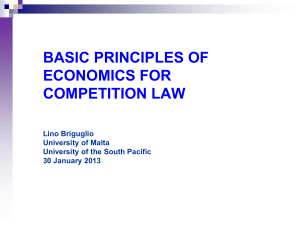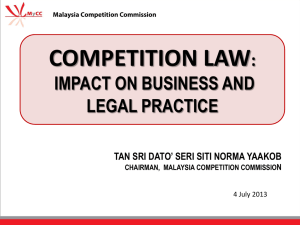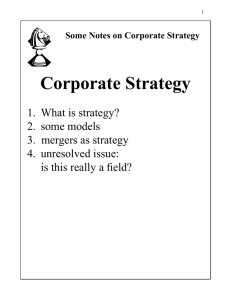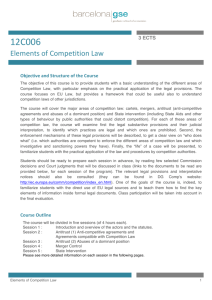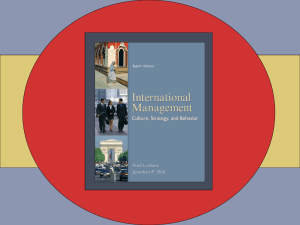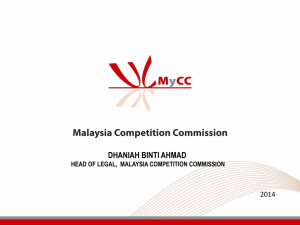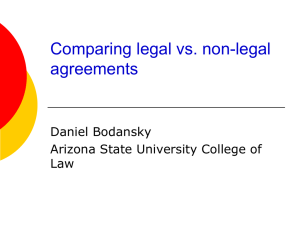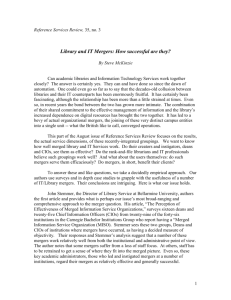Introduction to Competition Policy and Law
advertisement
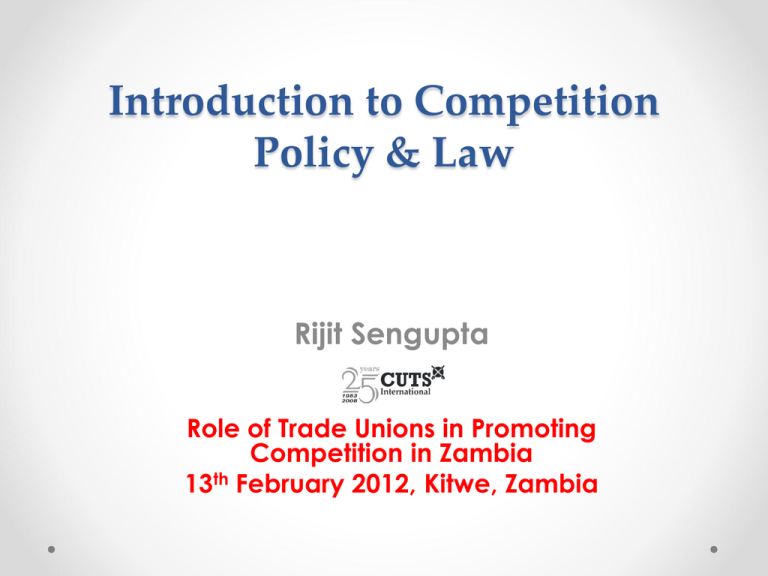
Introduction to Competition Policy & Law Rijit Sengupta Role of Trade Unions in Promoting Competition in Zambia 13th February 2012, Kitwe, Zambia What is Competition? • The process of rivalry between firms striving to gain sales and make profits • Motive: self-interest; outcome mostly beneficial for society (producers and consumers) • Competition is not just an event, but a process • It is not automatic – needs to be nurtured 2 Benefits from Competition • Producer benefits Market predictability (policy and practice) Efficiency (resource allocation) Innovation (productivity gains) Easy entry and exit (no barriers) • Consumer welfare Lower prices Better quality More choice Easy access 3 What is Competitiveness? • It is a comparative concept • Ability and performance of a firm, sub-sector or country to sell and supply goods and/or services in a given market • Firm competitiveness: compares a firm with its rivals in terms of quality and ability to supply goods • National competitiveness: awareness/preparedness of a country to challenges posed by global competition 4 Impediments to Competition? • Government Policy Difficult entry/exit conditions Absence of competitive neutrality (Favourtism) Non-transparent public procurement Implications of other policies • Anti-competitive Practices Restrictive Business Practices (Horizontal & Vertical) Unfair Trade Practices (misleading advert, bait & switch, false claims, etc.) • Lack of awareness and understanding Lack of buy-in among policymakers Lack of awareness, low public demand/support 5 Competition Reforms Promoting Competition COMPETITION POLICY COMPETITION REFORMS COMPETITION LAW Curbing Anti-competitive Practices (ACP) 6 Competition Policy • National Competition Policy Statement Govt. commitment to promote competition in all sectors Refinement of policies (trade policy, industrial policy, investment policy, procurement policy) for competition Ideally, a precursor to a competition law (sequence not followed) • Very few countries have a national competition policy (e.g., Australia, Botswana, Malawi, Mozambique, etc.) • Some countries are in the process of developing one (e.g., India, Uganda, Ghana, etc.) 7 Competition Law • Aims to protect process of competition and not competitors • Consist of a set of rules to curb ACPs • Competition Authority (CA) to implement the law • Over 130 countries have adopted a Competition Law • National and Regional Competition Law (EAC, COMESA, ECOWAS) • Often Competition Policy and Competition Law used interchangeably – NOT CORRECT 8 Provisions under a Competition Law • Anti-competitive practices of following types are prohibited: Anticompetitive agreements (collusion, cartels, etc.) Abuse of Dominance (exploitative or exclusionary) Anticompetitive Mergers • Competition Authority (CA) established with certain Powers & Functions • Linkage of CA with line Ministry and other Govt departments • Competition Advocacy (CA carries out activities to promote competition – SH sensitisation, policy reforms, public awareness, etc.) 9 Competition Authority • Agency created as per the provisions of the Competition Law • Main functions – investigative (Competition Commission) and sometimes adjudicative (Competition Tribunal) • Maintain functional autonomy, and be accountable • Public support is critical for its actions • Undertakes competition advocacy (through stakeholder engagements) • Cooperate actions with other regulatory agencies 10 Anti-Competitive Practices (ACPs) • Two types: Horizontal agreements and Vertical agreements Horizontal agreements - firms in same business (competitors) agreeing not to compete - Bid rigging - Output restrictions - Price fixing - Market allocation Vertical agreements involve firms in a suppliercustomer relationship - Exclusive supply/purchase agreements - Tie-ins - Resale price maintenance 11 Abuse of Dominance (AoD) • A firm in a dominant position abusing its position • Two ways: Exploitative and Exclusionary practices • Exploitative practices exploit customers of a dominant firm - Excessive pricing - Discrimination - Tied selling o Exclusionary practices aimed at driving competitors out of business - Predatory pricing - Refusal to deal - Hoarding (raw materials) - Exclusive dealing 12 Anticompetitive Mergers & Acquisition • Firms often try to avoid competition through Mergers • Three types of Mergers: Horizontal, Vertical and Conglomerate • Horizontal mergers involve reduce the number of players • Vertical mergers include firms in a supplier-customer relationship and can result in foreclosure • Conglomerate mergers involve firms in different lines of business, which could lead to considerable market power 13 Concluding Points • Effective competition enforcement results in both consumer welfare and producer benefits • SH need to understand their role in promoting competition • CAs need to strengthen SH communication/engagement • Policymakers need to prioritise competition reforms • Business should realise benefits of competition • Development partners/donors need to support the process 14 ZIKOMO! NATOTELA! Thank You rsg@cuts.org, lusaka@cuts.org www.cuts-international.org/ARC 15
